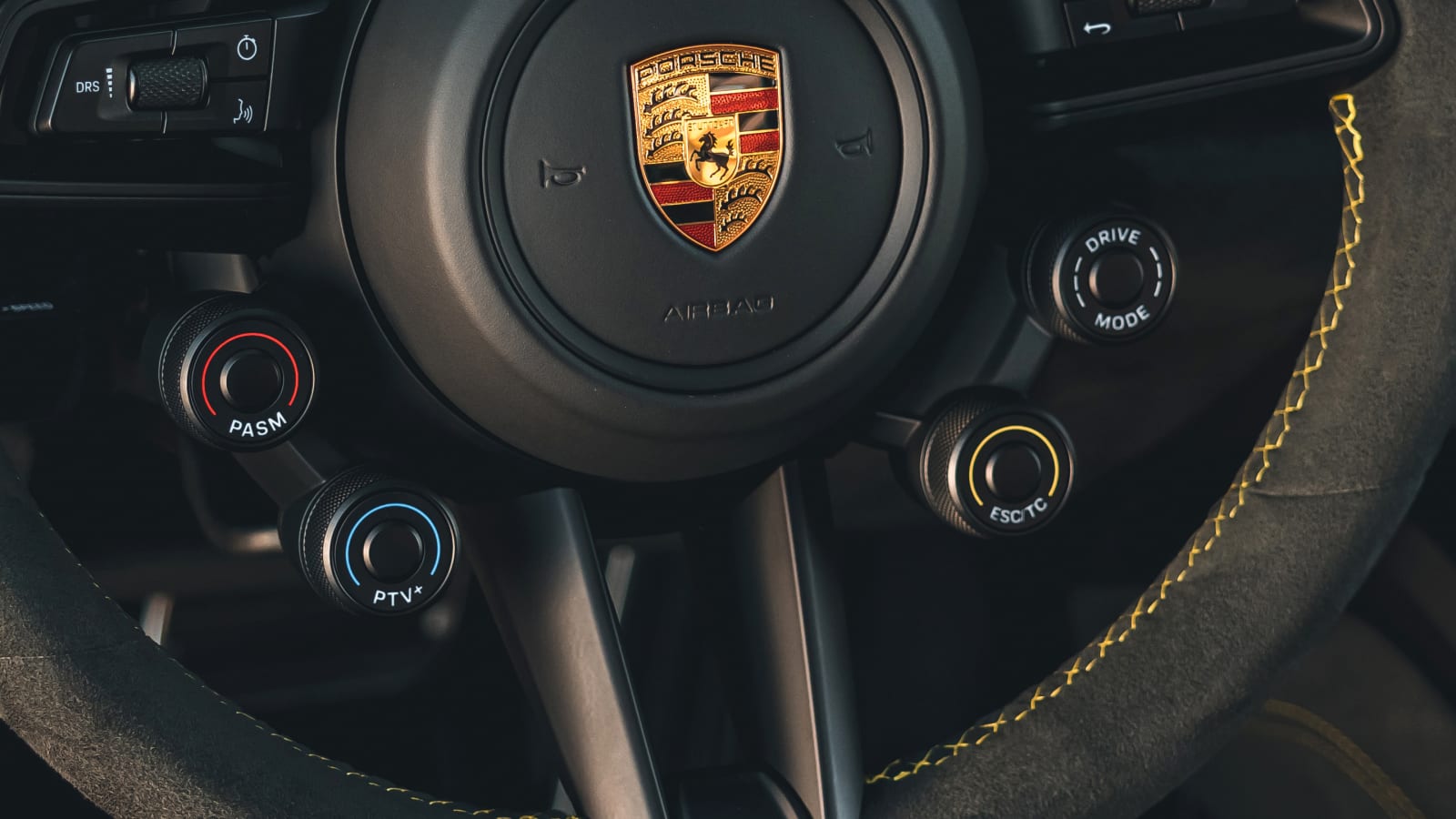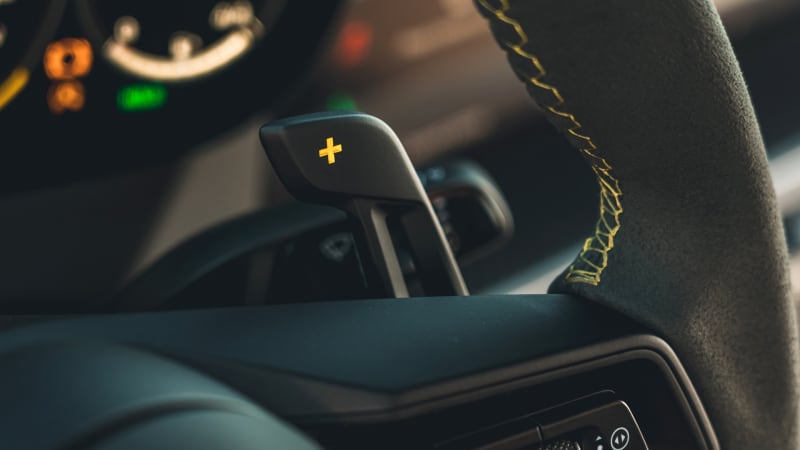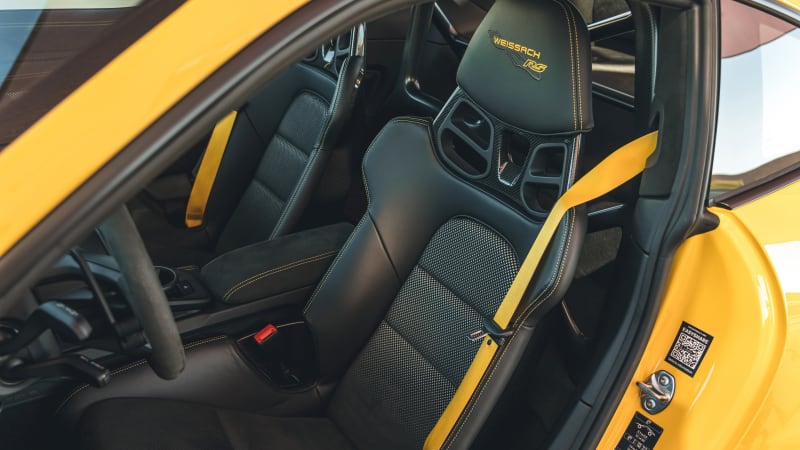THERMAL CLUB, Calif. — “Insufficient lateral support” isn’t exactly a common criticism that’s been levied at Porsche’s hardcore Full-Bucket Seat option. More like, “These need more padding,” or “Seriously, these don’t recline?” Yet, when popped into the 2023 Porsche 911 GT3 RS, the normally snug carbon-fiber uber-sport seats could suddenly benefit from even more support as the car furiously assaults each turn. And your body, too, because unless you’re a pro race driver, fighter pilot or astronaut, there’s a very good chance you haven’t helmed a vehicle capable of these types of G forces, either.
You see, this ultra 911’s multitude of aerodynamic elements flatten it to the road with more than twice the downforce (895 pounds) than the outgoing GT3 RS when going 124 mph, which we did here at the Thermal Club. Had we been able to manage 177 mph, it would’ve created 1,003 more pounds of downforce for a shake-your-head-absurd 1,896 pounds. That’s similar to Porsche’s previous-generation GTE LeMans race cars. So yeah, that enormous wing on the back isn’t just to impress the “Fast and Furious” crowd.
It’s still damn impressive, though. At 40% larger than the outgoing GT3 RS swan-neck wing, it’s the first time a Porsche road car’s wing is taller than the roof line. Not only that, it consists of two pieces, with a fixed portion and a hydraulically controlled, continuously adaptable element with an adjustment range of 34 degrees. It can’t get all the credit, though: The rear wing works in concert with a similarly adaptive underbody spoiler hidden up front, little fins mounted to the fully paneled underbody, and a rear diffuser. Even the front suspension’s double wishbones were stamped into a teardrop profile to increase front axle downforce by about 88 pounds.
And we’re just getting started. The rest of the great-many winglets, vents and cutouts further add downforce or ensure proper cooling. Those embedded within the giant hood vents guide hot air out of the unique single radiator that fills the space normally occupied by the 911’s frunk (the previous GT3 RS had three separate radiators). The novel roof fins are then crucial for ensuring that hot air doesn’t continue on into the engine’s air intakes under the wing. The body work aft of each wheel well is cut away and side blades are added to increase ventilation within the arches by 75% (there’s a downforce benefit here, too). The big holes in the rear fenders, which are engine air intakes in the 911 Turbo that donates its body to the GT3 RS, are repurposed to create vacuum and reduce air resistance at the rear.
And speaking of that Turbo donor body, only its fenders and roof are carried over in exterior panels. Everything else is carbon fiber, and not just for weight. The sharp crease in the doors needed to create that wheel well cutaway would be virtually impossible with the usual aluminum. That, in turn, resurrected the outgoing, 991.2 generation’s door handles since the current, 992 generation’s electrically-operated door pulls were a no-go with carbon fiber.
The available Weissach package, pictured above in yellow, swaps in even more carbon fiber (anti-roll bars, a shear panel at the rear, rear coupling rods) and magnesium wheels that alone shave 17.6 pounds of unsprung weight. Body panels are also left unpainted to better flaunt all that carbon.
Add it all up, and the standard GT3 suddenly looks quaint when parked next to the aero-festooned RS. A regular 911 might as well be camouflaged.

From a chassis perspective, the GT3 RS pulls from the usual Porsche bag of tricks: PSM stability control, PASM adaptive suspension, rear-wheel steering with “special sports tuning” and the PTV Plus torque-vectoring differential. Typically, those are controlled by selecting a drive mode or through switches on the dash that provide two or three adjustment options. The GT3 RS introduces something new, however: three knobs join the carryover Drive Mode selector in orbit below the main wheel hub. Porsche appropriately calls them “satellites.”
To set the car up ideally for a given track’s surface, the red PASM knob allows you to individually dial up or down by four levels each the amount of compression and rebound of the front and rear suspension. To set the car ideally to a track’s layout, the blue PTV+ knob allows you to dial up and down the amount of “Coast” and “Power,” or basically, how much you want the car to pendulum around its back end as a 911 is wont to do while still maintaining grip. Then, to set the car to driver preference or conditions, the yellow ESC/TC lets you choose amongst normal, dynamic and track stability control settings, and then given that selection, as many as seven possible levels of traction control.
Sound complicated? It sure is! There’s no way in hell you want to be fiddling a dial through 66 possible settings and a find-me-a-math-major number of possible setup combinations while going 95 mph through a chicane. Maybe (maybe!) turning a dial or two could be possible on a straight, but these are really intended to be futzed with in the pits between lap sessions in order to dial in the car just right for the particular track in question, plus your personal tastes. Basically, they replace the need to pit, put the car on a jack, break out tools and, realistically, hire someone to do it all for you.



You can also get someone to tell you how to set the satellites for the track in question. I opted for that, since Porsche’s on-hand pro drivers, Joerg Bergmeister and Patrick Long (above), had already put the cars through their paces at the Thermal Club and, you know, they’re pro drivers. Know when you don. It was the PTV+ settings that were more noticed on the track, as the car felt keener to rotate than it was on our get-to-know-you laps when the red and blue knobs were set to 0 or default. Keener, though, because we’re talking about seat-of-the-pants subtlety here. There’s nothing loose about it, not with all that downforce and chassis wizardry. This is a car that didn’t scare me, but it sure made obvious it was capable of a far greater pace than this combination of track and hack were capable of. I did not have that impression when I drove the last GT3 RS at Road Atlanta several years ago – I felt like I could swing it in that car’s league. This one? Send me back down, coach.
Perhaps that shouldn’t be surprising since the new GT3 RS sliced nearly 11 seconds off the outgoing car’s Nürburgring Nordscheife lap time. Eleven! Coincidentally, that’s also the amount you’ll be slicing off from the new, regular GT3.
At this point, it probably seems ridiculous that I haven’t gotten around to mentioning the powertrain, but the changes made to the 4.0-liter naturally aspirated flat-six are comparatively slight. All those lopped-off seconds can be attributed to all of the above. Still, no complaints will be lodged about an engine that angrily wails at a high enough volume to still be loud while wearing a helmet. Listening to it rev out beyond 8,000 rpm makes you want to shout “hell yeah!” and high-five someone. The 4.0 now produces 518 horsepower (up by 16) and 343 pound-feet of torque (down by 3 lb-ft), while going from zero to 60 mph in … ah, who cares? If you want something to drag race, get a 911 Turbo. Or a Taycan. This spectacular naturally aspirated engine is about the response, the sky-high redline and, oh yes, the noise.


It’s paired exclusively to a seven-speed PDK transmission, versus the eight-speed PDK found elsewhere in the Porsche lineup. One fewer gear equals less weight. Like other PDKs, though, this one does such a superlative job of knowing exactly when and by how much to shift that I never once thought to use a paddle shifter. Well, until I remembered Porsche fitted new magnetically actuated magnesium paddles to the GT3 RS and wanted to make sure I sampled the delightful metallic clack that comes with each gear change. Something to enjoy out on the open road.
Sadly, I did not get the chance to do that, but honestly, that’s not what this car is about. You might even feel a bit silly pulling up to a restaurant in a car with roughly 148 aerodynamic flourishes attached to its body. Nope, you buy this for the track, and having a membership to something like the Thermal Club to properly and routinely enjoy it would be a tremendous idea. I might not have been able to fully swing it in its league, but the speeds with which I was achieving while doing my best to stay glued to Bergmeister or Long driving regular GT3s were still nuts for this rather tight and technical track. There’s a reason I was uncharacteristically sliding about in those Full-Bucket seats … and found myself just a wee bit sore the next day.
Perhaps paying $274,890 for something that makes one feel inadequate in skill and physicality wouldn’t be the wisest for one’s mental well-being, but it would be worth the practice and trips to the gym to try and rise to the challenge. What a car.
Source: https://www.autoblog.com/2023/02/28/2023-porsche-gt3-rs-review/


